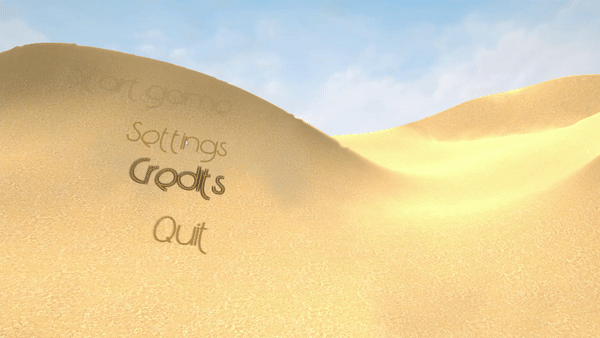
Sand
September 2019 - October 2019
Sand is a short, atmospheric walking sim created in 6 weeks as a solo project. The task of the project was to create a level that guides the player to the end without the use of any text. The game is about an unprepared traveler who is lost in a vast desert without any water.
Main Menu Wire-framing
For the main menu screen, I am trying to evoke feelings of being alone in a scorching desert. I plan to render the menu as a 3D scene in Unity, with the text options appearing in-line with the dunes. The selected text will acquire a bright glow effect, while other options oscillate between two intermediate levels of opacity (for example, 40-80%) and slowly shift positions. The purpose of this effect is to play into the hallucinations that occur within the game by making the text appear ephemeral. When an option is selected on the main menu, I want to have the text dissolve and be swept away to the right, as if it is being blown away. I plan to also incorporate a heat wave effect over the image, which is what the blurred and shifted lines in the prototype signify. I intend to use sound effects that are like the ones used in Shadow of the Colossus. They are very deep and hollow, like blowing into a large pipe. They convey the feeling of emptiness that one can feel in a barren place far from civilization.
Wireframe of Main Menu
The in-game Main Menu
Upon selecting the settings button, I made the camera rotate 90 degrees on the y-axis and move downwards, as if the viewer is falling into the sand. The camera then looks at the sky, with a hot sun beating down. The sky serves as the backdrop for the settings menu. The main sub-menus live on the left third of the screen, with the sun being on the right third. When sub-menus are selected, the options for those menus appear on the right 2/3rds of the screen, with a darkened panel below them so that they are easily visible against the sun. Since the sub-menus are still visible when a sub-menu is open, players can move between sub-menus without returning to a central menu. For the options themselves, there are drop down menus, sliders, and boxes. I’m intended for this game to be playable only with mouse and keyboard, so drop down menus work better than the arrow style of multi-selection that is seen in titles like Alien: Isolation. The sliders have input boxes as well, as that is often more convenient for players using mouse/keyboard.
Wireframe of Options Menu
In-game options menu
For the pause menu, I have the character exhale and use an effect that looks like the character is closing their eyes (black comes in from top and bottom of screen). The Resume, restart, settings, and quit options appear here. Behind the text I intend to have a highly transparent brown dust effect moving around to add some dynamism to the menu. Upon resuming the game, the eye closing effect reverses (also known as eye-opening), and the game resumes. As a note, going into settings from here would not have a camera panning effect, since there are problems regarding the player’s positioning when this occurs.
Wireframe of Options Submenu
In-game Options Submenu
What I Learned
I worked a lot on the UX of the game, somewhat to the detriment of the level design. I did a lot of exploring on the use of audio for improving player's immersion in my game, to a lot of success. I made several background tracks that switch at distinct points in the level to invoke the emotion in the player that I want that area to represent. I wanted to work a lot on refining small UX details. For instance, sweat appears on the screen based on how hot you are (heat builds up over time and the exact value is hidden to the player), and there is a button mapped to wiping sweat off your face. Play-test data suggested that small details like these are what really sold the experience.
Speaking of level design, that was my biggest shortcoming in this project. I didn't plan the level well at the beginning of the project, and decided to change the whole second half of the game about midway through the project. My giant change was definitely better than my original design, but I lost a lot of time. The design of the level itself ended up being very basic and on-rails. The interior area, The Pyramid, suffered the worst. I never was able to flesh it out the way I wanted, and it pretty much just serves as a hallway to bring you to the end of the game.












